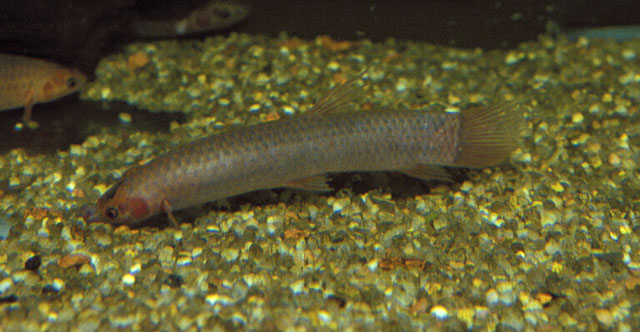| Phractolaemidae (Hingemouths) |
| 25 cm TL (male/unsexed) |
|
benthopelagic; freshwater; pH range: 6 - 8; dH range: 25 |
| Africa: in West Africa from Lake Nokoué (Ouémé River, Benin) (Ref. 81277) to Cross River (Cameroon) (Ref. 52397), including Ogun, Osse and Niger Delta (Ref. 81277). Also in the middle Congo River basin (Ref. 93183) in Republic of Congo and Democratic Republic of the Congo. |
|
Dorsal spines (total): 0-0; Dorsal soft rays (total): 6-6; Anal spines: 0-0; Anal soft rays: 6-6; Vertebrae: 34-38. Diagnosis: head depressed and strongly ossified; anterior nostril elongate, forming an oblique, forward-pointing tube; posterior nostril crescent-shaped, located just behind the narial tube (Ref. 2913, 81277). Mouth small, protrusible (Ref. 245, 31256, 81277), placed at tip of a proboscis and opening upwards between the narial tubes (Ref. 2913, 81277), on upper surface of snout (Ref. 245, 31256). Narrow gill opening, but opercles very well developed, covering also the underside of the head where they overlap (Ref. 2913, 81277, 93183).
Description: head bony (Ref. 2913), depressed, with very broad, slightly convex interorbital region (Ref. 2984). Pair of small nasal barbels (Ref. 31256). Jaws with only two teeth, at symphysis of lower jaw (Ref. 245). No pharyngeal teeth (Ref. 3062). Swim bladder divided into numerous small alveoli and adapted to airbreathing (Ref. 245). All fins spineless; dorsal and anal fins each supported by 2 simple and 4 branched rays; scale formula: 3.5/35-38/4.5; 3.5; 16; lateral line complete (Ref. 2913, 81277). Scales longitudinal striated (Ref. 2984, 31256), large (Ref. 2984), cycloid (Ref. 245, 3062). 16-20 medio-dorsal scales, 12-16 scales in front of pelvic fins, 11-12 between pelvic fins and vent; 27-30 precaudal vertebrae, 8 caudal vertebrae (Ref. 93183). Accessory epibranchial respiratory organ on 4th branchial bone (Ref. 3062). Pectoral fins rounded, pelvics pointed, caudal fin rounded (Ref. 2984). Details on internal anatomie (including skeleton) can be found in Ref. 93182, tubercle morpholgy in Ref. 38266, details on swim bladder anatomy in relation to air breathing in Thys van den Audenaerde 1959, some details on osteology in Gosline 1960 and details on cranial osteology in Ridewood 1905.
Coloration: uniformly brown; fins generally colourless and transparent, but the unpaired fins may be tinged with red (Ref. 2913, 81277). Some scales silvery with golden reflection, especially on posterior part of body where they may form longitudinal lines (Ref. 41580). |
| Lives in forest pools and swamps (Ref. 41580). Microphagous (Ref. 4910, 41580, 45483), especially phytophagous (epiphytes), and detritiphagous (Ref. 41580). Swim bladder entirely alveolar, functioning like a lung; this adaptation to aerial breathing allows the fish to survive under poor oxygenation conditions (Ref. 2913, 81277); recorded from nearly deoxygenated lungfish nest in Pool Malebo, Congo DR (Ref. 41585). Gonads, which are largely fused, are situated ventrally, not dorsally, in abdominal cavity (Ref. 41580). Mouth can be projected as a small trunk (Ref. 2913). Eggs transparent, yellow-greenish, 1.5-1.7mm diameter; large females may have several thousands of eggs (Ref. 41580). Particular blood system, with dark coloured and an abundant amouth of blood (Ref. 4910). |
|
Least Concern (LC); Date assessed: 05 June 2019 Ref. (130435)
|
| harmless |
Source and more info: www.fishbase.org. For personal, classroom, and other internal use only. Not for publication.

